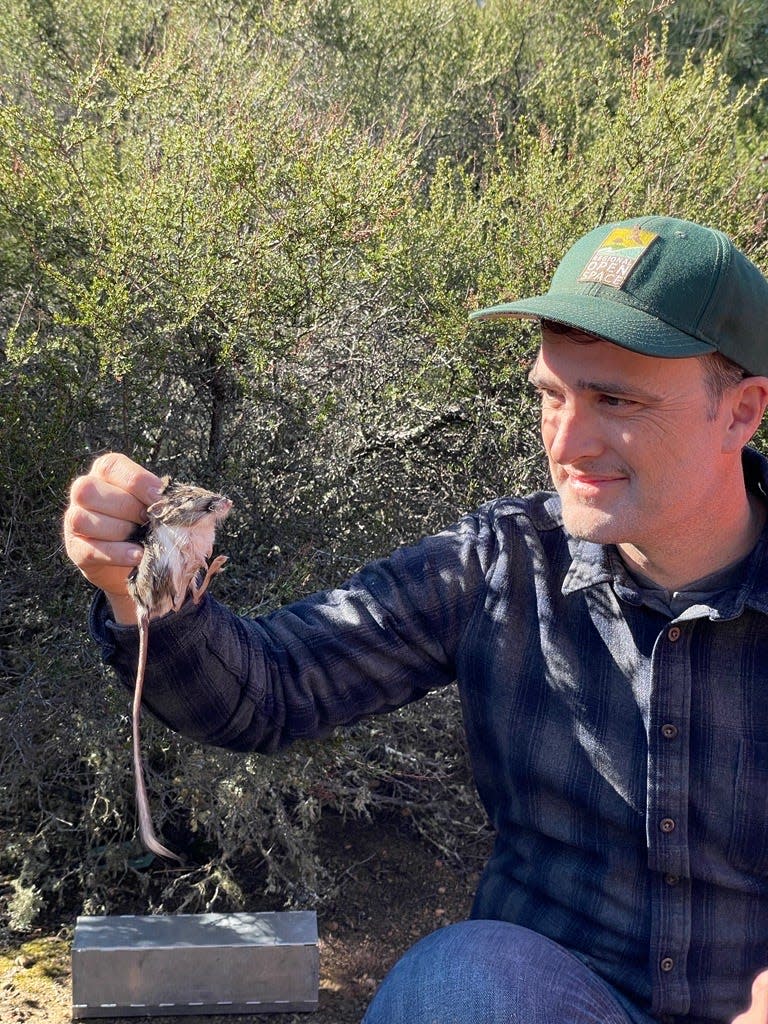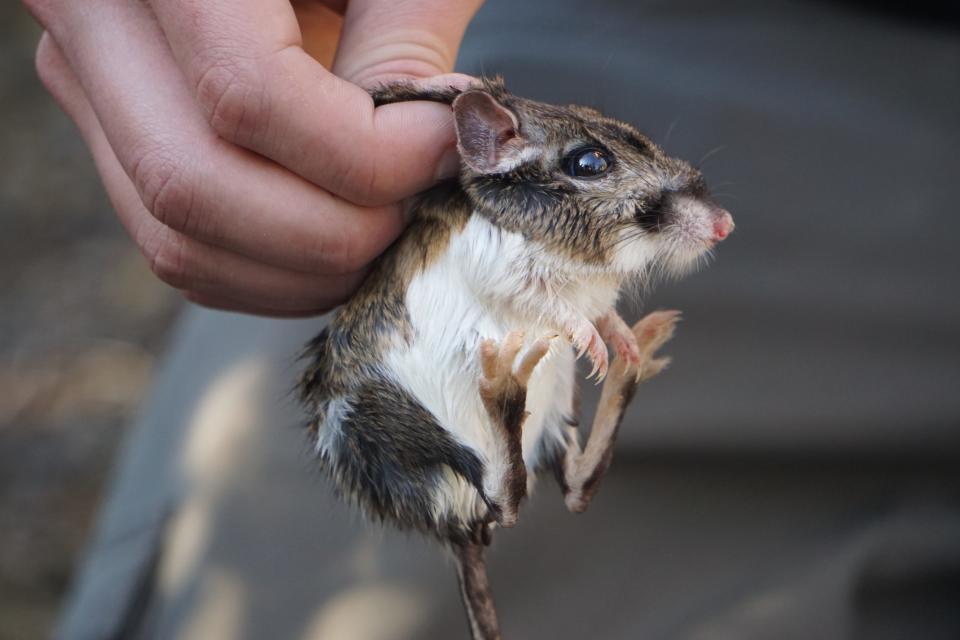California researchers find elusive kangaroo rat not seen in years
Researchers have finally found a tiny animal they’d been seeking for years in a California nature preserve.
The Santa Cruz kangaroo rat has been documented at Henry Cowell Redwoods State Park in Felton, California and now, researchers believe they've found some in the Sierra Azul Open Space Preserve as well.
Genetic testing still needs to be done to determine for sure that the creatures in Sierra Azul are Santa Cruz kangaroo rats but based on their body measurements, everything checks out, said Matt Sharp Chaney, a wildlife biologist from the Midpeninsula Regional Open Space District.
The rodents have large hind legs with "unusually long" tails, the agency said on its website. The non-hibernating, tiny, elusive rodents often eat seeds and they actually don’t need water since they can get it from foods, the district said.
While Sharp Chaney doesn't know the exact origin of the kangaroo rat's name, they stand on their hind legs, much like a kangaroo. They are also one of the only bipedal mammals in North America, or animals that walk on two legs.
"The way they get around by hopping on those hind legs very much looks like how a kangaroo gets around," he told USA TODAY. "And they are rodents, although they are not that closely related to rats. They're actually more closely related to chipmunks and pocket gophers."They also have big pouches in their cheeks that they use to store materials, also like kangaroos, he said.

Giant African land snails: Giant African land snails put parts of Florida under quarantine
Endangered and threatened species: U.S. states with the most and least endangered species
Researchers found kangaroo rats. What’s significant about that?
Santa Cruz kangaroo rats are listed by the California Department of Fish and Wildlife as a critically imperiled subspecies. In other words, they are at risk of being wiped out completely.
The animal is also a keystone species, which means their behaviors have a large impact on the plants and animals the kangaroo rat lives among, the Midpeninsula Regional Open Space District said.
Take manzanita, for example. Kangaroo rats bury manzanita seeds and keep them from heating up too much when a fire passes through. The smoke and ash from these fires increase germination of these seeds, creating more manzanitas.
Sharp Chaney said researchers don't know how many kangaroo rats are in Sierra Azul but so far, they've logged about 10.
Wildlife biologists are trapping and studying the animals and plan to do more this summer and fall. They are also preparing to conduct a capture study where they trap the kangaroo rats and tag their ears. That's how they'll know if they've already been accounted for and put a number on the current population.
When’s the last time these animals were seen in the area?
Prior to this year’s discovery, the Santa Cruz kangaroo rat was last seen in 2019 in Sierra Azul by an independent researcher, the Midpeninsula Regional Open Space District said.
And before that, the creature wasn’t seen in Santa Clara County since 1947, the district said in a Facebook post.

Finding the kangaroo rats is largely due to the hard work of local photographer and ecologist Ken Hickman, according to Sharp Chaney.
Hickman approached the agency in 2016 wanting to help find species that hadn’t been spotted in the area in quite a while. He built custom wildlife cameras and planted them throughout the preserve, ultimately finding the tiny creatures in 2019.
What’s next for this tiny creature?
The Santa Cruz kangaroo rat is part of a habitat assessment program so researchers can learn where these animals thrive. From there, an SCKR Habitat and Population Monitoring Plan will be created to help the subspecies.
The district’s plans include four phases and are mapped out to 2027 or later.
Researchers say the animals live in five specific locations within Sierra Azul, in addition to the population in Henry Cowell Redwoods State Park.
To help sustain the population, the Midpeninsula Regional Open Space District is supporting a team from UC Davis, UC Santa Cruz, and CalPoly San Luis Obisbo as they do genetic research.
Using steel traps to catch the kangaroo rats, researchers are able to briefly collect data, learn more about them and then release them back into the wild, according to an NBC video on the district’s YouTube page.
The results will include an assessment of the subspecies’ genetic diversity and help determine whether a listing status is needed for the species under the California Endangered Species Act, Sharp Chaney said.
"There seem to be very few populations in existence," he said. "Historically, there were far more and the populations themselves don't seem to have that many individuals in them."
Researchers will also conduct plant surveys to add to the Santa Cruz kangaroo rat’s habitat and population management plan. The plan will help identify opportunities to increase the likelihood that the population survives.
What have researchers learned about Santa Cruz kangaroo rats so far?
Researchers said the kangaroo rats in Sierra Azul are pretty spread out and can't get to each other easily. Habitat availability is lacking for them and there's just "not a lot acreage of what looks like suitable habitats" for the creatures, Sharp Chaney said.
"If you pull up aerial imagery of the area on Google Earth and backtrack through time, even as early as just the 1990s, not that long ago, when you look at these habitats where we find kangaroo rats, now, that used to be much, much more open," he said.
Areas with lots of bare ground, which kangaroo rats need to get around, have disappeared.
Typically areas in the mountains with lots of shrubs burn in regular intervals. It's not happening due to fire suppression though, he said.
"Where these areas would normally have big wildfires moving through and opening space up, that's no longer happening," he said. "That means we have to do some other management to try and open these habitats up a little bit more for them."
From there, kangaroo rat populations in Sierra Azul can get to each other.
"It's really important for us to try and keep them on the landscape, try and understand where they are and help protect that habitat and enhance that habitat so that they can stick around," he said.
This article originally appeared on USA TODAY: Kangaroo rat in California spotted after disappearing for decades

